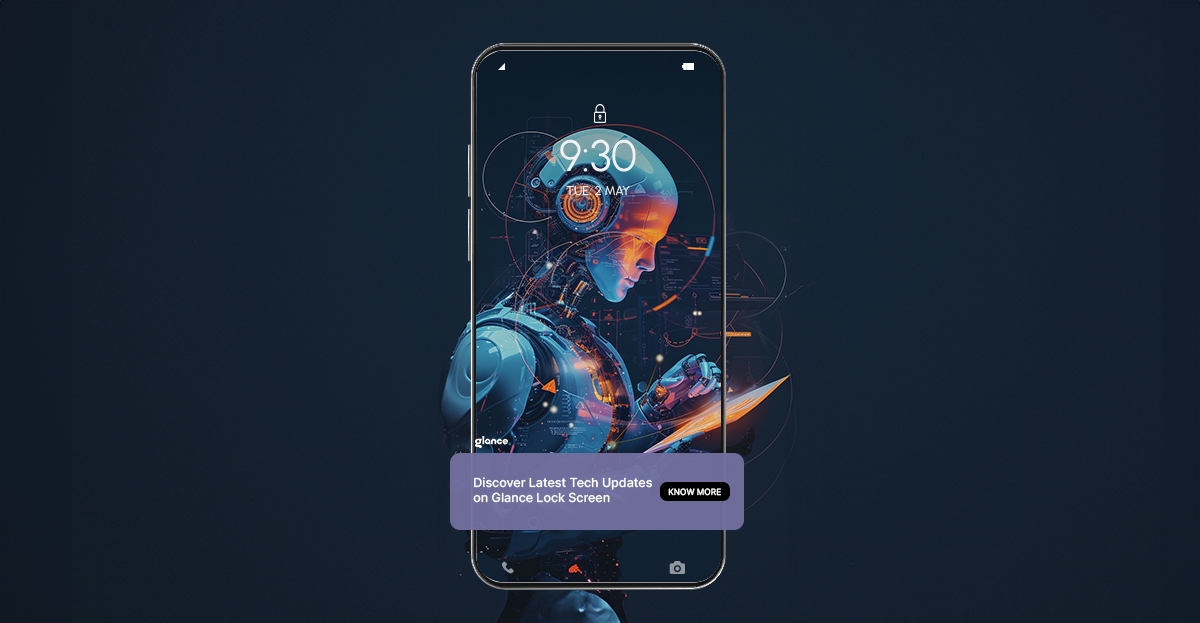In the mobile industry, AI technology has emerged as a game-changer, revolutionizing how we interact with our devices. Among the various applications in AI technology, Visual AI stands out as a powerful force shaping the future of smartphones.
This blog explores the concept of Visual AI, its implementations, and its impact on mobile technology, with a special focus on innovative features like the Glance smart lock screen.
Understanding Visual AI: The Eyes of Your Smartphone
Visual AI represents a subset of artificial intelligence that focuses on analyzing and interpreting visual data. It's the technology that allows your smartphone to "see" and understand images and videos in real-time. This capability opens up a world of possibilities, enhancing user experiences and enabling new functionalities that were once the stuff of science fiction.
At its core, Visual AI uses complex algorithms and machine learning techniques to process visual information. These systems can recognize objects, faces, text, and even interpret emotions from images. The applications of this technology are vast, ranging from improved photography features to advanced security systems.
Visual AI in Action: Real-World Applications
Enhancing Mobile Photography
One of the most noticeable implementations of Visual AI is in smartphone cameras. Features like portrait mode, night mode, and super-resolution zoom are all powered by Visual AI algorithms. These systems analyze scenes in real-time, adjusting settings and applying enhancements to produce professional-looking photos without the need for expensive equipment.
Facial Recognition and Security
Visual AI plays a crucial role in mobile security features like Face ID. By analyzing facial features and patterns, these systems can accurately identify users, providing a seamless and secure method of device authentication.
Augmented Reality Experiences
Visual AI is the backbone of many augmented reality (AR) applications. By understanding the physical environment through the camera, Visual AI can overlay digital information onto the real world, creating immersive experiences for gaming, education, and more.
Text Recognition and Translation
Visual AI powers optical character recognition (OCR) features in mobile devices. This allows users to extract text from images or translate foreign languages in real-time simply by pointing their camera at signs or documents.
The Glance Smart Lock Screen: Visual AI at Your Fingertips
A prime example of Visual AI in action is the Glance smart lock screen, primarily available on Android devices. This innovative feature demonstrates how Visual AI can transform even the most basic smartphone functions into intelligent, personalized experiences.
How Glance Works:
The Glance smart lock screen analyzes user interests and behaviors. It then curates and presents relevant content directly on the lock screen, creating a dynamic and engaging experience every time you check your phone.
Key features of Glance:
-
Personalized Content: Visual AI analyzes your interests to display news and entertainment that resonates with you.
-
Dynamic Visuals: The system understands what type of images grab your attention, ensuring a visually appealing lock screen.
-
Contextual Awareness: Glance can adapt its content based on factors like time of day, location, and user habits.
The integration of Visual AI in the lock screen goes beyond simple text recommendations. It creates a rich, visual experience that keeps users informed and engaged without even unlocking their devices.
Visual AI and the Broader AI Landscape
While Visual AI focuses specifically on interpreting visual data, it's essential to understand its place within the broader context of AI technology. AI, in general, refers to computer systems that mimic human intelligence, including learning, problem-solving, and decision-making capabilities.
Visual AI complements other AI technologies to create more intuitive and powerful mobile experiences. For instance:
-
Natural Language Processing (NLP): While Visual AI interprets images, NLP allows devices to understand and respond to voice commands, powering virtual assistants like Siri and Google Assistant.
-
Predictive AI: This technology analyzes user behavior patterns to anticipate needs and preferences, working alongside Visual AI to create more personalized experiences.
-
Machine Learning: The backbone of many AI systems, machine learning allows Visual AI and other AI technologies to improve over time as they process more data.
The Future of Visual AI in Mobile Technology
As Visual AI continues to evolve, we can expect to see even more innovative applications in mobile technology. Some potential developments include:
-
Advanced Biometric Security: Combining facial recognition with other biometric data for enhanced device security.
-
Intelligent Camera Assistants: Cameras that can understand scenes and suggest optimal settings or compositions in real-time.
-
Enhanced AR Experiences: More seamless and realistic augmented reality applications for both practical and entertainment purposes.
-
Visual Search Capabilities: The ability to search the internet using images rather than text, directly from your smartphone camera.
A Visually Intelligent Future
Visual AI represents a significant leap forward in mobile technology, transforming our smartphones from mere communication devices into intelligent companions that can see and understand the world around us. From enhancing our photos to personalizing our lock screens, Visual AI is already making a substantial impact on our daily mobile interactions.
As we look to the future, the potential of Visual AI in mobile technology seems limitless. We can anticipate even more intuitive, personalized, and visually rich experiences that seamlessly blend the digital and physical worlds. The Glance smart lock screen is just one example of how Visual AI can enhance our interaction with mobile devices, and it's exciting to imagine what other innovations lie ahead.
In this visually intelligent future, our smartphones will not just be tools we use, but perceptive assistants that truly understand and respond to our visual world. As Visual AI continues to advance, it will undoubtedly play a crucial role in shaping the next generation of mobile technology, promising a future where our devices are not just smart, but visually intelligent.



